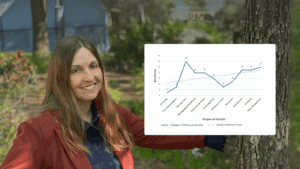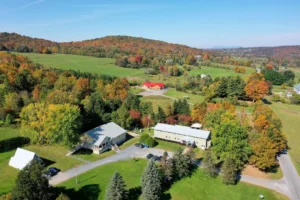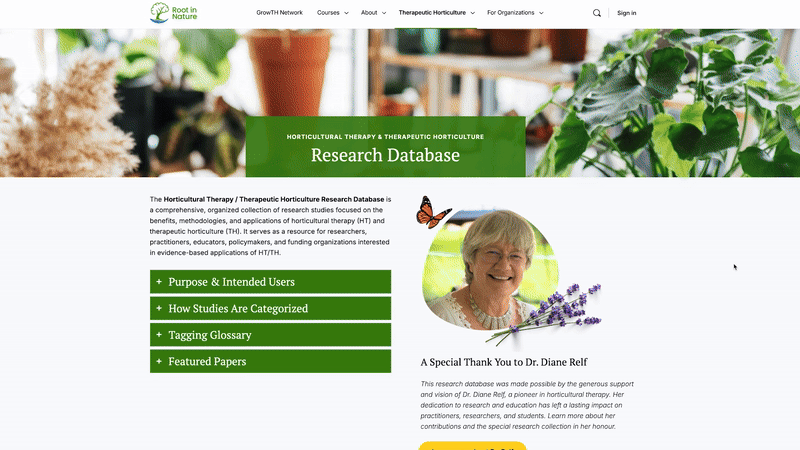When you’re deep in a busy season—or watching the budget tighten—it can feel like nature-based programs are at risk of being cut.
Maybe you’ve seen your supply budget disappear.
Maybe you’ve had to fight to keep a program running.
Maybe you’ve been the only one who seems to understand just how much this work matters.
If that’s where you are, you’re not imagining it. And you’re definitely not alone.
We hear from recreational therapists, horticultural therapists, and other allied health professionals all the time who are being asked to do more with less. Less time. Less money. Less support. And still—you show up. You adapt. You make it meaningful.
That’s why we wrote this blog. Not just to validate how hard you’re working, but to offer some real, practical ways to strengthen your therapeutic horticulture practice in this challenging landscape.
These aren’t shiny “start a whole new program” ideas. They’re low-cost, high-impact ways to keep your practice grounded, your skills growing, and your clients supported. And to make it even easier, we’ve included a few free resources—simple tools you can start using right away, no extra budget needed.
Table of Contents
Lead with Simple Activities That Make an Impact
You don’t need extra tools or fancy supplies to offer a meaningful therapeutic experience. Some of the most effective activities use what’s already around you—and connect people to themes like growth, reflection, and care.
A great place to start? Seed starting.
It’s tactile, hopeful and encourages reflection, and it’s easy to adapt for different populations. And best of all—it doesn’t require expensive materials or a greenhouse.
To offer support, we’re sharing two free resources you can use in your therapeutic gardening sessions:

Seed Starting Activities: A Practical Guide for Therapeutic Horticulture
This guide includes variations based on population needs, sensory prompts to deepen engagement, and thoughtful ways to add meaning to the experience.

Seed Starting Best Practices Handout
From recycled containers to indoor lighting tips, this quick guide is designed to support confident, successful seed starting sessions—no matter your experience level.
You can run seed starting activities indoors or out, year-round, using minimal materials. It’s a strong reminder that therapeutic horticulture doesn’t have to be complicated to be effective.
Use Evidence to Support Your Program
If you’ve ever been told to “prove the impact” of your program, you’re not alone. It can be frustrating to see the transformation in your clients, but struggle to translate that into language your funders or supervisors will take seriously.
That’s where research can help—but finding the right studies in a sea of academic articles isn’t always realistic for busy practitioners.
We created the Root in Nature Research Database to make advocacy easier. It’s a curated hub of over 500 peer-reviewed articles and case studies organized by population and setting—so you can find what you need quickly.
Whether you’re writing a grant application, pitching a new initiative, or working to ensure your program stays supported, this resource helps you speak the language of outcomes, evidence, and effectiveness—quickly and clearly. In a world where funding can shift overnight and programs are being questioned more than ever, having credible, well-evidenced research at your fingertips isn’t just helpful—it’s essential.
Your work is rooted in science. Now you can show it, with confidence.
Invest in Your Own Growth
Many practitioners are stretched thin—and still feel that pull to keep learning and growing. But when time is limited, even the idea of more training can feel out of reach.
If that’s where things stand right now, here’s something to keep in mind: investing in your own growth doesn’t take away from your clients or your program—it strengthens them.
Sometimes, the smallest shift—learning a new approach, seeing your work in a new light—can be exactly what you need to feel refreshed, re-energized, and more connected to the work you do every day.
That’s exactly why our Intro to Therapeutic Horticulture Course was designed to be flexible, self-paced, and supportive—not overwhelming.
It’s for practitioners who want:
- A solid foundation in therapeutic horticulture
- Practical, ready-to-use strategies
- A better understanding of how to adapt activities for different goals and settings
- Confidence to lead sessions and explain their value
Whether you’re new to therapeutic horticulture or already running programs but want to go deeper, this course helps you build your skills and language—at your own pace.
It’s not about adding more to your to-do list. This course meets you where you are and helps you feel stronger and more supported in the work you’re already doing.
One of our students Carmen Viljoen recently shared:
“I absolutely loved the Intro to Therapeutic Horticulture course! The format was engaging, the information was incredibly insightful, and the GrowTH network offers outstanding resources.”
Build a Community Around You
One thing that comes up again and again from practitioners:
“I care so much about this work—but it feels lonely sometimes. Like I’m doing it on my own.”
If you’re the only one running a garden or nature-based program at your site, it can feel isolating. You’re making it up as you go, tweaking plans at night, and trying to find someone—anyone—who gets it.
And while the impact on your clients might be clear, it’s easy to wonder:
“Is anyone else doing this?”
“Am I doing this right?”
“Where can I go for support?”
That’s why we created the GrowTH Network. It’s a space for therapeutic horticulture practitioners to connect, ask questions, share what’s working, and get support from people who actually understand this work.
Inside the GrowTH Network, you’ll find:
- A private community of practitioners
- A growing activity database
- Monthly calls and seasonal events
- Discounts on Root in Nature training, including the Intro Course
It’s not just a place to get ideas—it’s a place to feel seen. To feel encouraged. To remember that you’re not the only one doing this kind of work, even if it feels that way sometimes.
GrowTH Network Member Testimonials
If you’re not quite ready to join the Network just yet but still want to stay connected, you can always sign up for our Root Beat newsletter.
Each month, we share helpful guides, research spotlights, trending topics, and practical ideas you can use in your sessions—delivered straight to your inbox, for free!
Let’s root into what’s possible—even in hard seasons
If you’re working with limited time, limited funding, or limited support… you’re not failing. You’re doing your best in a system that wasn’t built to fully support this work (yet).
But with the right tools, a little community, and a reminder that you don’t have to do it all alone—you can keep your practice strong.
Start small. Try a new activity. Learn something new. Reach out to someone who gets it.
You’ve got the heart—we’ll help with the how.
🌱 Download the Seed Starting Activities guide
🌱Take a look at the Intro Course and GrowTH Network
We’re here when you’re ready!
Latest from the blog

How Therapeutic Horticulture Supports Social Work: Practical Tools for Clients and Practitioners
Root in Nature will be releasing a series of blogs that explore the intersections of therapeutic horticulture and allied fields. Each piece will highlight how plant- and nature-based practices can support the unique goals of different professions. Social work is the starting point for this series, reflecting the essential role it plays in supporting individuals, families, and communities.

The Practitioner’s Map: Navigating the 9 Stages of Therapeutic Horticulture Program Growth
Starting a therapeutic horticulture (TH) program can feel like planting seeds in unfamiliar soil – filled with anticipation, hope, and, let’s be honest, a bit of uncertainty. Whether you’re developing a new initiative in a long-term care home, school, community space, or healthcare setting, the journey often follows a set of recognizable emotional and operational stages.

Client Spotlight: Dunham House – Cultivating Patience, Healing, and Community Through Therapeutic Horticulture
Dunham House is a residential treatment facility located on 85 acres in Quebec’s Eastern Townships. It provides a calm, natural setting designed to support adults recovering from mental health challenges and addiction. Through its one-month and six-month dual-diagnosis programs, Dunham House offers evidence-based therapy alongside innovative, nature-based activities, one of the most impactful being its therapeutic garden program, which helps residents build skills, confidence, and connection through hands-on gardening.


